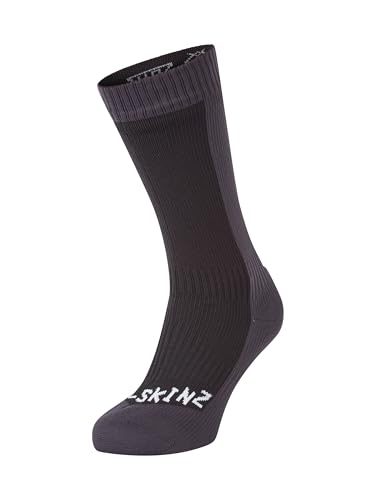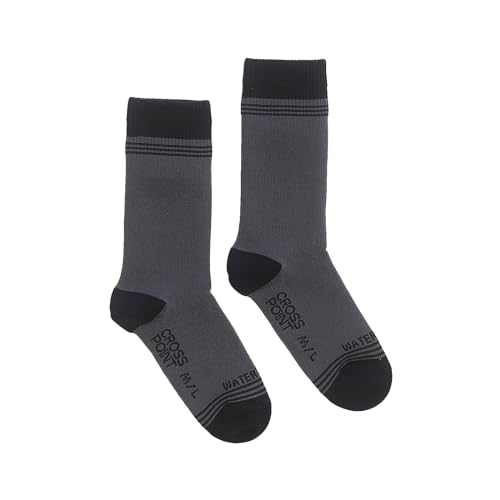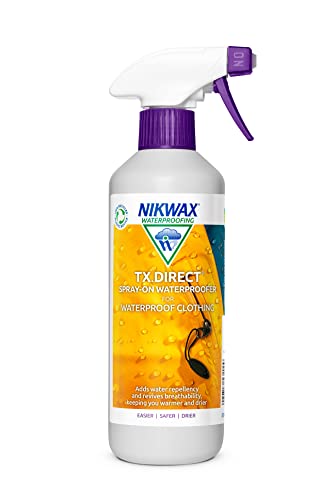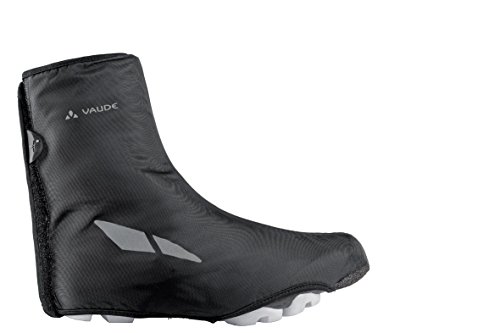This post may contain affiliate links, which help to keep Discerning Cyclist rolling. Learn more.
Given how much it rains in this country (160 days a year on average), cyclists have an ongoing and troublesome relationship with wet weather – or more specifically, how to stay dry in it. It’s a truly miserable thing to be wet and cold on a bike, and to still have miles ahead of you.
And one of the worst parts of that misery is, undoubtedly, wet feet. Wet feet lose heat around twenty five times faster than dry feet, which accounts for why they feel so cold, so quickly, when the rain sets in. So, for a comfortable ride in the rain, it’s worth investing a little to keep them dry, and there are a range of ways you can do this.
So many in fact, that we asked the Discerning Cyclist audience to help us navigate the sheer breadth of options, and we had a fantastic response. We’re devoting much of this post to them, and their excellent recommendations and tips.
A huge thank you to our audience for all of your input, and for helping us to ensure that wet feet could soon be nothing more than an unpleasant memory.
How Do I Keep My Feet Dry When Cycling?
You’ll need to do this through your footwear – waterproof shoes, socks or cycling overshoes. Waterproof trousers with shoe covers are also an option. Or, you can go for a waterproof spray. Lastly, there are cheap DIY hacks – a simple plastic bag being the most common.
Keeping the rest of your body dry when cycling isn’t such a problem. There are a vast number of decent waterproof jackets and trousers on the market, along with alternative options such as a good poncho (unless it’s blowing a gale). It’s also important, and relatively easy, to take care of your bike after a heavy shower.
But because of the position of your feet, taking the brunt of splashes and spray, it’s extremely difficult to protect them completely. You’ll probably find that you’ll need a combination of waterproof gear to achieve this.
Waterproof Socks for Cycling
For those on a budget, waterproof socks can provide a good, cheaper solution to keeping your feet dry, as many find that they work wonders even if the shoes around them are saturated.
Regardless of whether you’re using waterproof shoes as well, our audience had clear favourites in terms of which socks will keep the moisture (and the cold) at bay:
“I always wear Sealskinz socks if there’s any chance of rain or puddles. I find they work wonders. You have to get the triple lined ones with the rubber seal at the top but they keep you warm too.“
Nigel Bambridge
- Waterproof and breathable - three layer construction for warmth, durability and waterproofing
- Merino wool lining for moisture control, insulation and comfort
- Support - zonal elastication for added support. Flat toe seams provide comfort and prevent rubbing and blisters
Christine Justice wears “waterproof socks from Showers Pass,” in which her feet “stay perfectly dry.” In a downpour, her shoes become wet quickly, but the socks don’t. This way, she can keep wearing her beloved trainers, “Until it gets too cold, then the ugly winter boots come out.”
- 40% Merino Wool (Outer sock is made of 78% Nylon, 15% Polyester, 7% Spandex. Inner Sock is 40% Merino Wool, 40% Acrylic, 17% Polyester, 2% Spandex, 1% Nylon)
- A 100% waterproof membrane is 3-D molded to a merino wool knit interior for superior warmth and comfort. A proprietary micro-porous membrane allows for perspiration to escape, providing a breathable...
- A nylon exterior provides protective durability and abrasion resistance while hiking, running, cycling, walking or daily wear |A cushioned toe box provides exceptional comfort and foot care while...
Waterproof socks are also, as Andy Booker echoes, “much cheaper to replace than bike shoes.” The Sealskinz are an evident winner among our readers, including Eden Clay, who also uses them along with trail runners with Gore-Tex lining.
For the vegans out there who may be feeling squeamish by now, rest assured that Sealskinz socks are not made from seals – although they do use Merino wool in many of their socks, which is an animal derived product. However, they also offer vegan options with Bamboo lining, which is sustainable and great for the environment.
It’s also worth noting that the Sealskinz socks for cyclists have a Hydrostop Barrier to help prevent water coming in through the top of the sock.
READ THE FULL GUIDE: Best Waterproof Socks for Cycling
Waterproof Shoes for Cycling
There are a range of shoes that are waterproof – some designed specifically for cycling and others for walking or other sports such as running. If you’re not using clipless pedals then you’re not limited to the kind of shoe you can use.
Remember that a shoe might be completely waterproof, but if it’s a low fit then the top of the shoe will need to be protected to prevent water coming in as it runs down your legs – which is inevitable in heavy rain.
Here’s what our audience recommended as the best waterproof shoes for cycling:
“I’m currently riding with some black Chrome Truk Pro SPD shoes. They are pretty stealth and with recessed cleats you don’t often get the ‘click clack crunch’. My one major grumble would be that they are slightly on the heavy side, but that’s the only real trade off.”
Mark Warne
Rebecca Norton stated that, “The best shoes I found for keeping your feet dry in terms of trainers are the Cloud Waterproof trainers. They aren’t cheap but I changed to them around two years ago when they first came out and have never looked back.” She does recommend wearing waterproof trousers too, as the trainers “are a relatively low fit”. For something taller, she suggests the Cloudrock Waterproof speed-hiking boot, which is “more expensive and a bit bulky on SPD pedals, but still good.“
Gore-Tex is clearly a popular brand with many of our readers. James Prudhomme uses Gore-Tex shoes from Ecco. He told us, “I just bought a pair and looked great riding from Walthamstow to Soho on my new Ampler e-bike.“
Andy Booker rightly states that: “The trouble with most cycling shoes is that they have ventilation. Not great for keeping the damp out.” His solutions are his “trusty Merrell Gore-Tex lined trainers and flattie pedals. Not ‘cycling specific’, but good enough for a 10-minute dash.” And for longer journeys where “British” weather threatens, “I wear my Northwave clipless shoes but pair them with sealskinz socks. The shoes may well be waterlogged after a couple of hours chasing Strava segments, but my feet will be dry.”
Richard Himan told us that his Ecco Gore-Tex trainers have served him well: “I wore them on the 2019 NYC 5BBR – 45+ miles in torrential rain and my feet remained dry. They also have shoes and boots in the range if you’re looking for something more stylish.“
Gore-Tex is also the choice for Alex Weiss, who uses “low-top Gore-Tex hikers on rainy days”, since he ditched his clipless pedals for regular flat pedals.
If you’re after affordable comfort, Vernon Botha recommends Quoc Weekenders: “They’re amazing. Waterproof, and so, so comfy. Don’t look half bad and great value for money!“
“My favorite water-resistant sneaker is the Vans Ultrarange Exo MTE (the MTE part is the water-resistance). They are supremely comfortable, have solid grip for winter riding (I use thin platform pedals and they work great), and come from a trusted brand with some retro style. I found them for $60 during a biennial sale, they usually run about $100. At that price point, they’re still a good deal. My feet haven’t been wet yet. Not great for a downpour, but anything less than that you should be okay.”
Drew Pearson
Other brands that our readers suggested were Adidas Velosamba, “Tretorn Boots!” (Peter Böhm), and the “all weather” Vivobarefoot (Harry Malcom). The (always-affordable) Decathlon’s Men’s Fitness Walking Shoes PW 580 was also highly recommended.
For our vegan readers, animal-friendly options include waterproof trainers from Vessi Footwear, recommended by Philip King, who told us, “I have a pair of Weekend-style sneakers because they look the most casual and least sporty. They just look like normal sneakers. 100% waterproof and environmentally friendly.” Unfortunately this Canadian brand doesn’t ship to Europe. They can be shipped to America, using a PO Box service, and then on to Europe. This may sound awkward, but Philip feels they’re worth it for those keen to have a casual-looking and eco-friendly shoe: “They look great. You wouldn’t tell they are waterproof or technical by looking at them.”
Eden Clay uses Salomon or Merrell, both of which offer vegan footwear.
Waterproofing Sprays for Shoes
Waterproof sprays for shoes can be quite effective, but less so in very heavy rain as the shoe seams can leak. The best sprays should be suitable for all types of shoe material, but consider what type of shoe you’re using – those with large ventilation holes will be difficult to seal with a spray.
Before spraying, your shoes should be totally dry in order for the spray to soak in. You should also leave time for the spray itself to dry after coating.
You may also want to consider coating your shoes with waterproof wax, which is cheaper and (some feel) more effective than a spray. The downside is it takes longer to do.
Mark Warne found that his black Chrome Truk Pro SPD shoes “were water resistant for the first couple of rides and in lighter summer showers,” but he’s been “topping them up with Fjallraven Wax” in order to maximise their protection.
Christine Justice, in addition to using waterproof socks, treats her “favourite trainers with Nikwax”.
Tom Steen uses Obenauf’s LP Paste with Danner Hiking Boots Mountain 600 (smooth leather): “The smooth leather holds the Obenauf’s well and will be about as waterproof as you want. The boots are not heavy and super comfortable so you will be happy wearing them all day. They look great too.“
- NIKWAX TX.DIRECT SPRAY ON: This spray is an easy to use, high performance waterproofer which adds water repellency to the areas that need it most without tumble drying. Designed to enhance performance...
- SUITABLE FOR ALL WATERPOOF FABRIC: Whether it's jackets, pants, gloves, or other outdoor apparel, Nikwax Direct Wash In works effectively on a variety of fabrics, including Gore-Tex, eVent, and other...
- SUITABLE FOR ALL WATERPOOF FABRIC: Whether it's jackets, pants, gloves, or other outdoor apparel, Nikwax Tx.Direct Spray works effectively on a variety of fabrics, including Gore-Tex, eVent, and other...
Cycling Overshoes
Cycling overshoes are not only a great investment for keeping your feet dry, but they can also keep your feet much warmer, providing an extra layer against the elements. Some have thicker material on the inside for better insulation.
On a long, wet ride, it’s likely that some water will seep in over time, so choose overshoes with good protection at the ankle. A strong, waterproof zip is also a must, along with taped seams.
Not all overshoes have zips, and this can be a good idea as it means there’s less to break. Though putting them on can take a little getting used to.
If you are looking for zipless, Mike Jenic told us: “Having tried a lot of different shoes and overshoes I’ve found the best combination is a pair of regular shoes with the Endura Zipless Overshoes.”
Neoprene is also highly regarded as the best material – totally waterproof but less breathable than Polyurethane:
“I personally think that overshoes are great. No faff at all. I even use them when I am commuting to work and cycling with ‘work’ shoes rather than cycling shoes. Even when there is no rain they keep shoes clean and toes toasty. Perhaps you should give them a try. Neoprene is the best, and do look for those with the strongest zip.”
Daniel Barreto
Rapha was mentioned more than once in our audience responses. Matthew Hawley stated: “I use Rapha Overshoes and just leave them on the shoes.” And Rob Thomas agreed with him: “I always wear overshoes. Even when I have normal office shoes on! Rapha does some great overshoes.“
Spatz Overshoes were recommended to us also, and I would add the durable and visible Sealskinz All-Weather Cycle Overshoe at a mid-range price.
- Shoe covers for bike sports
- water repellent, wind repellent and breathable
- thermal, comfortable cut
Waterproof Trousers with Shoe Covers
Waterproof cycling overtrousers are ideal for those who want to slip something on without needing to change. Being light and easy to pack away, they’re also useful to carry for unexpected rain showers, and those with shoe covers offer exceptional protection for the feet, too.
“If it’s raining on my commute I wear my waterproof trousers from Decathlon that have shoe covers attached. They are completely brilliant and keep my feet totally dry.”
Lucy Flower
I’d second this. Again, the brilliant and often underrated Decathlon. They offer truly affordable clothes that always seem to do the job. I’ve had many Decathlon products and I’ve never been disappointed.
DIY Hacks
If you want to save money, or are simply after extra insurance against foul weather, there are some cheap DIY solutions that you can try.
Plastic Bag
Of course, the trusted and effective plastic bag. Robert Paynter told us: “I have used standard carrier bags with an elastic band in the past. Make elastic bands from a wide strip of haberdashery elastic with a knot – not a stationery rubber band.”
The plastic bag goes over the shoe, and the elastic band should be over the trousers, securing the plastic bag underneath. Robert assured us that this is “perfectly good for commuting a few miles”.
Some people prefer to put the plastic bag inside the shoe. Whatever works for you.
Milk Bottle Toe Clips
Robert also told us about an old colleague of his, Will Jeffries, who came up with an ingenious way of keeping his feet dry using foot guards made of “6 pint plastic milk bottles, which he attached to his pedals and toe clips. I guess they were a bit more hassle to get feet into, but methods could be worked out to ease that!”
Drysuit Wrist Seals
Another DIY hack – and this is a slightly strange one – is to use use the wrist seals from a drysuit and pull them over your leg to cover the top of your waterproof socks. They shouldn’t cost you more than about £6, and you may need to cut them to size.
Our Recommendation: Chrome 415 Storm Workboot
This comfortable, stylish and fully waterproof boot was our choice of protection for wet days, and some of our readers agreed with us – especially Wojciech Mazurkiewicz and Steve Bercu.
“I found anything below the ankle will result in soggy feet because of water going through the socks. Now I have the Chrome 415 Storm Workboot and they feel great!”
Wojciech Mazurkiewicz
So, whether you’re out in the rain for fun, or you’re determined that the moist British climate isn’t going to deter you from cycling to work – whatever your journey throws at you, you can feel confident that squelchy wet feet needn’t be a part of it.
A super stylish waterproof boot for cycling. Looks great in day-to-day urban life and has a stiff sole to maximise your efficiency when pedalling.
🇬🇧 UK: £158
🇪🇺 EU: €179
🇺🇸 US: $160
Read More:



